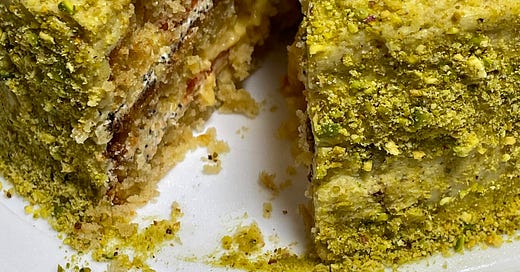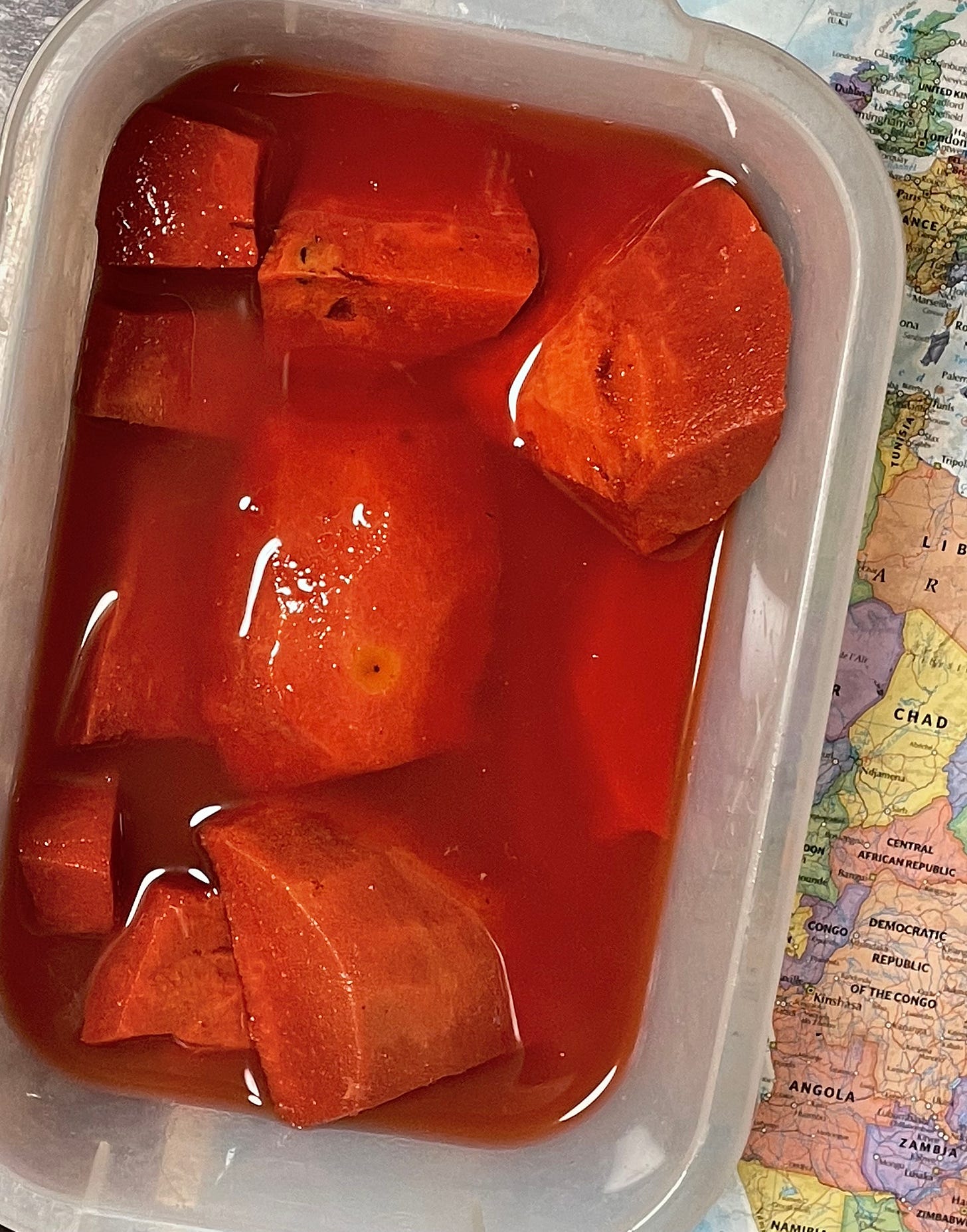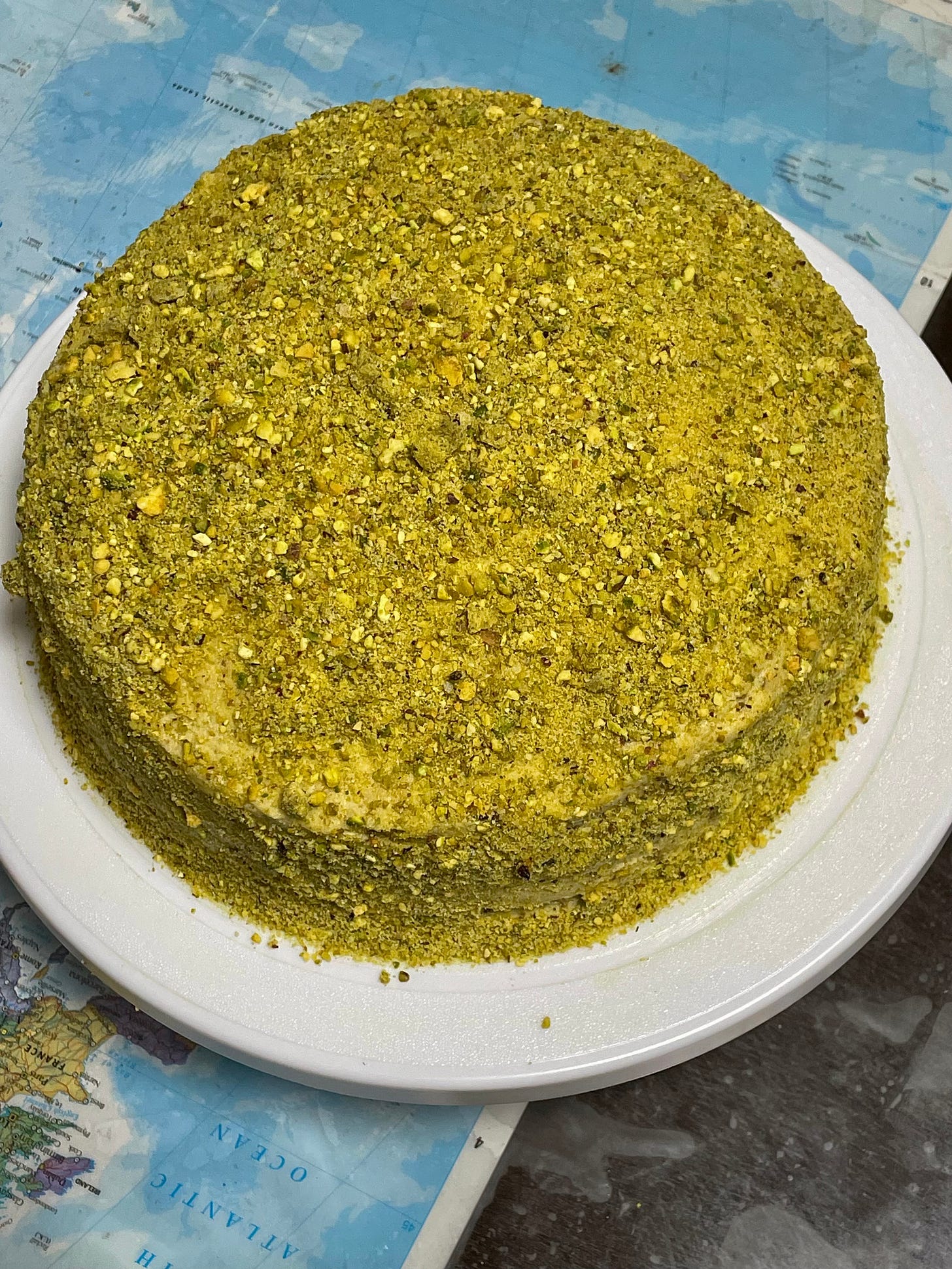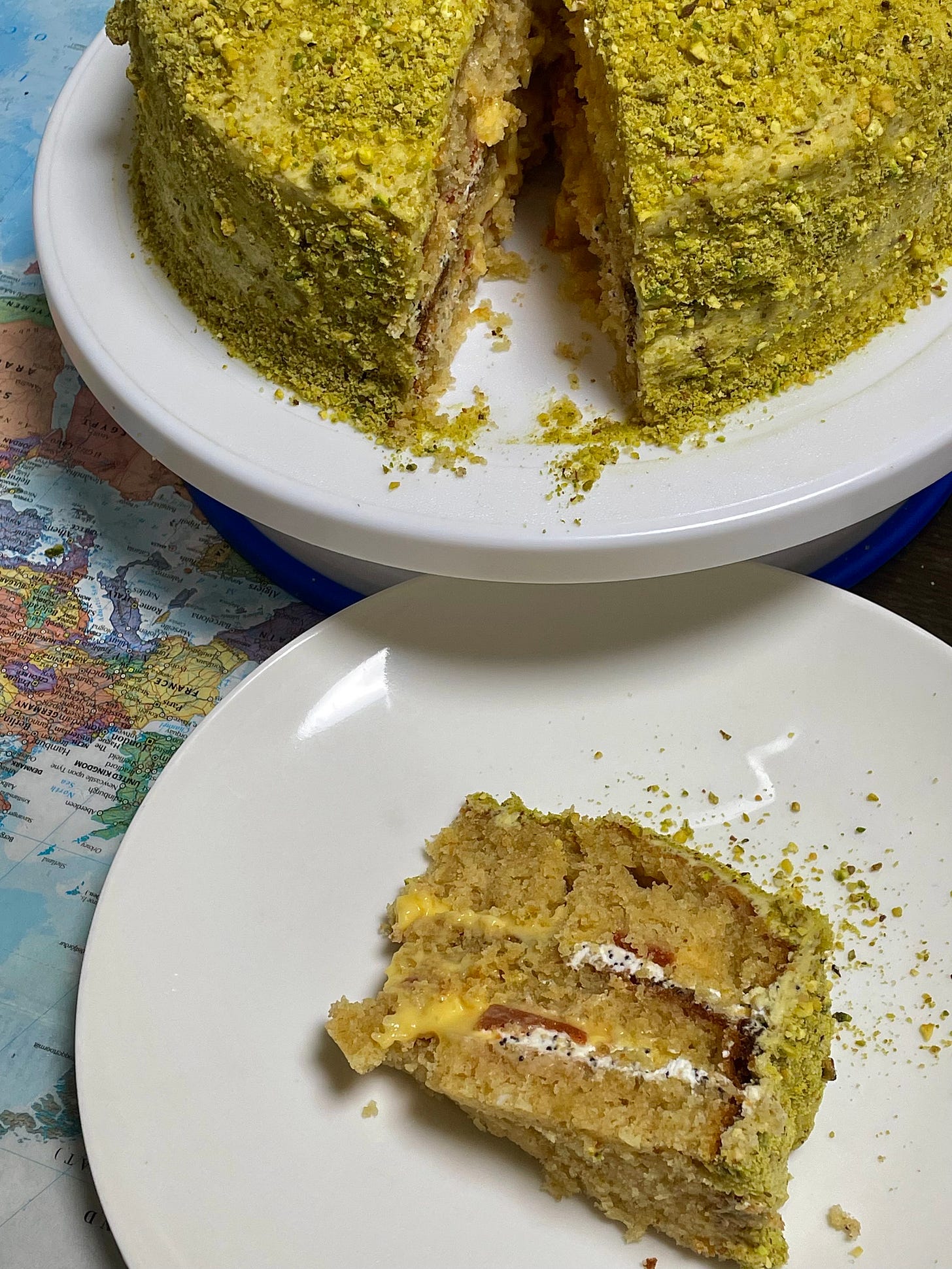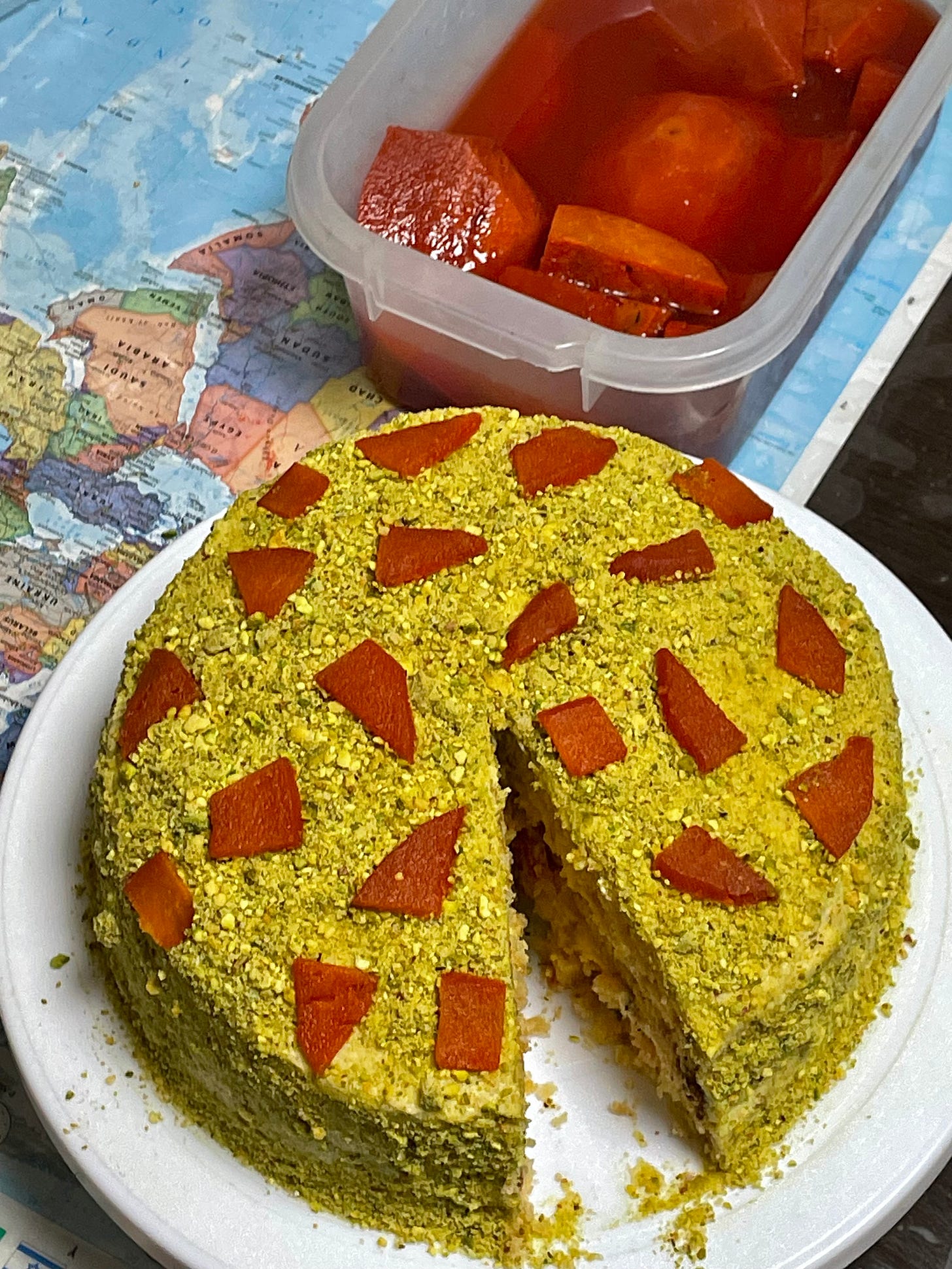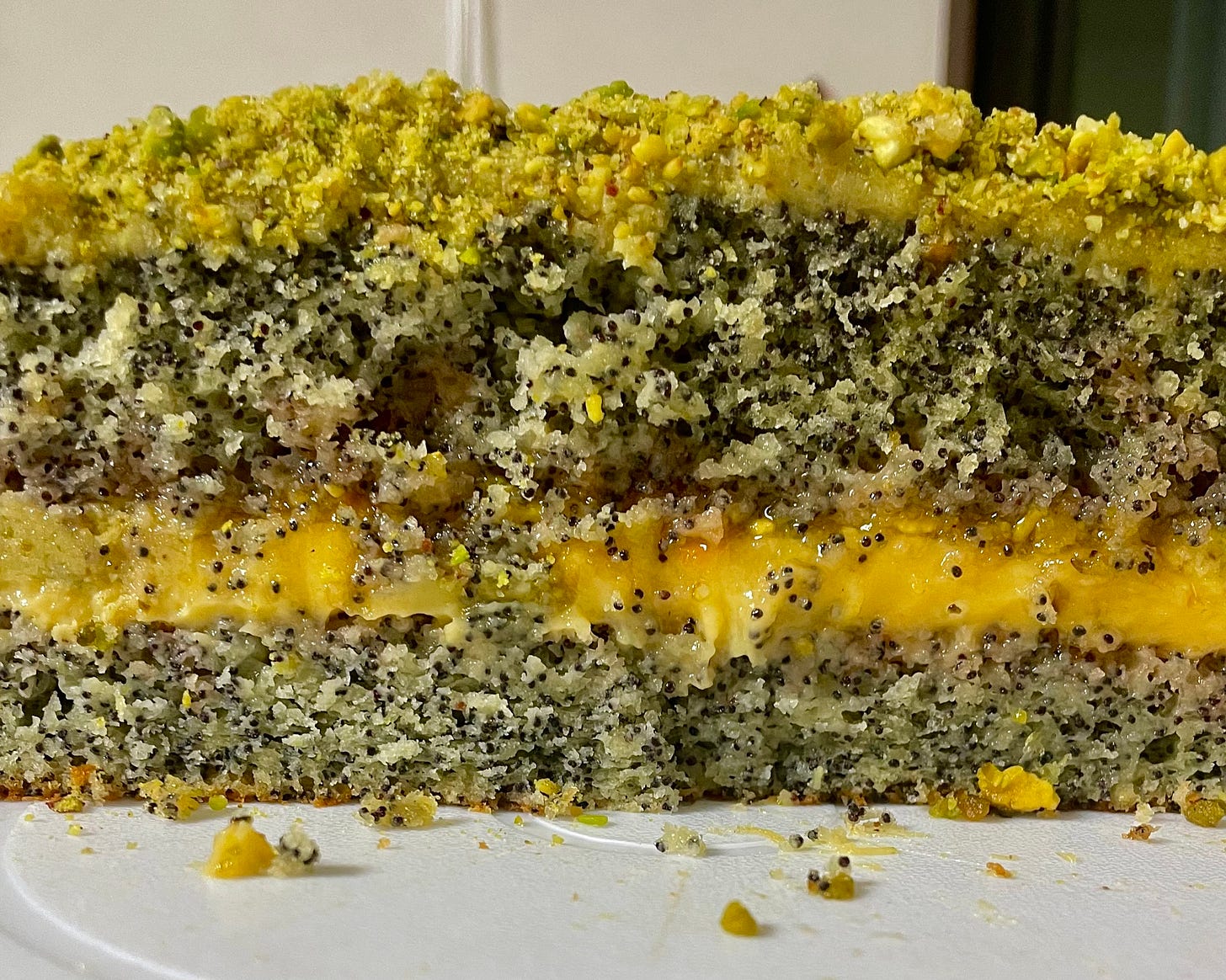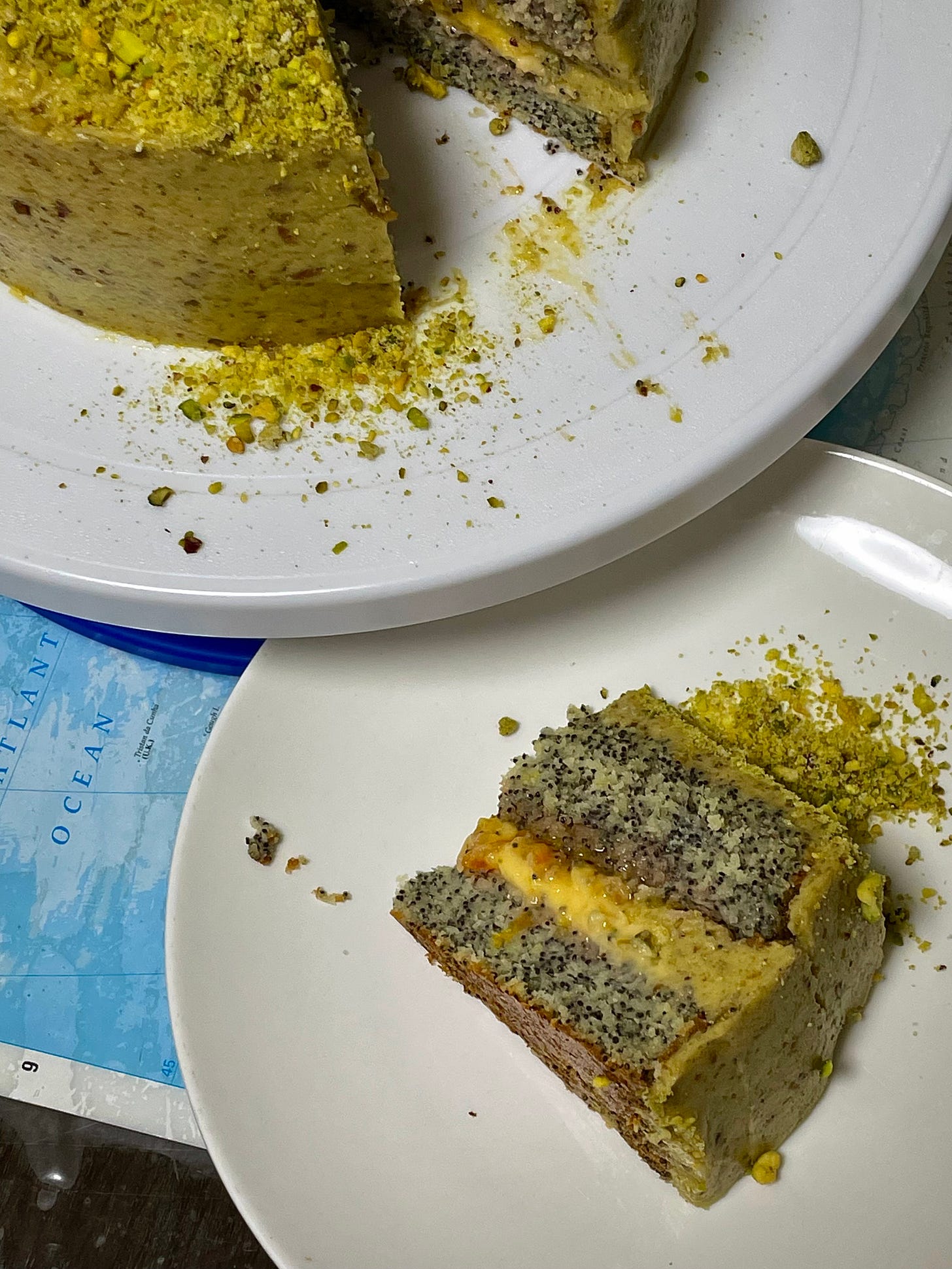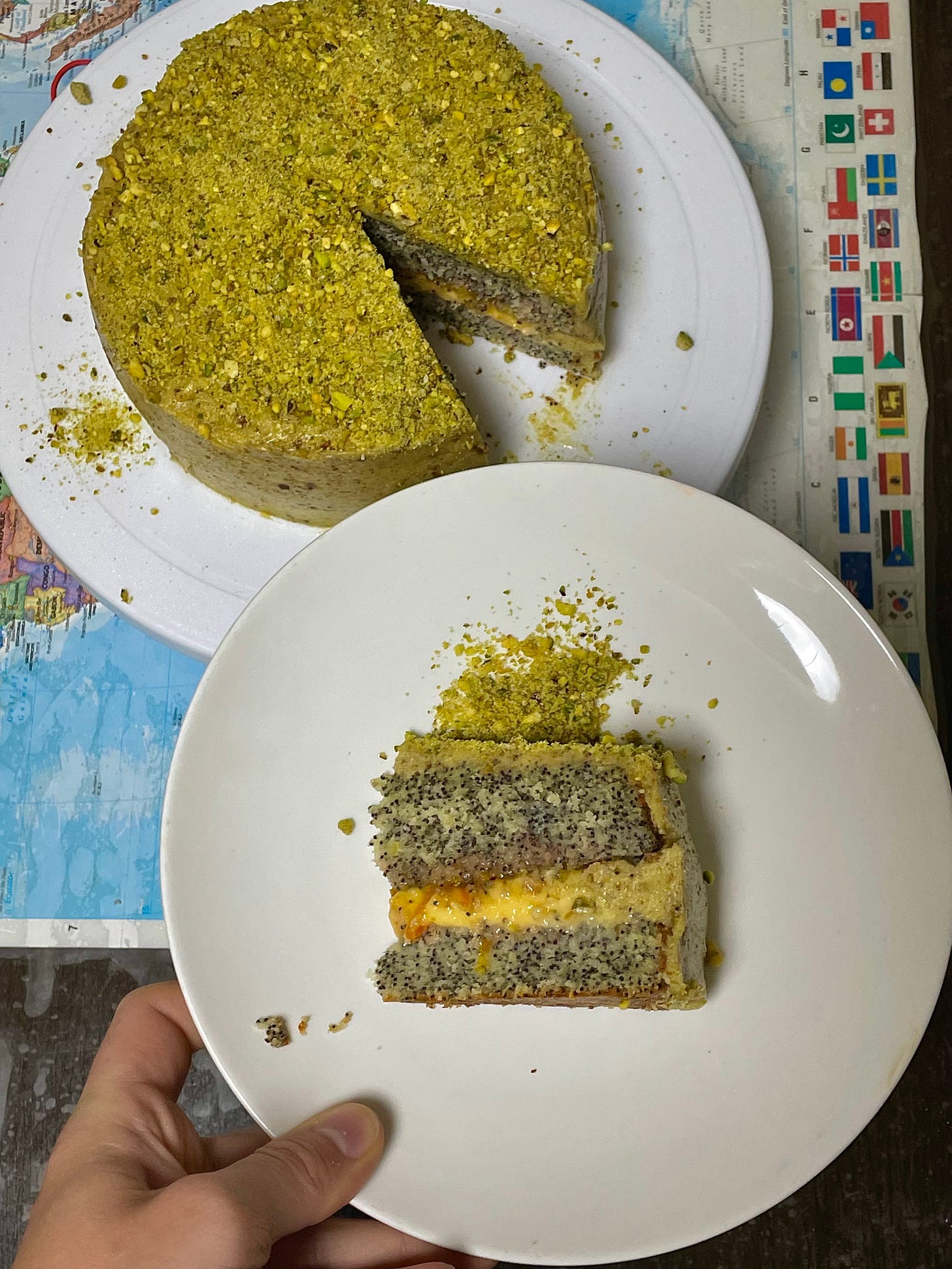Olive Oil Cake with Quince, Creme Pat, Poppyseed Cream and Pistachio Swiss Meringue
A tribute to Rose Wilde.
I recently asked my 18-year-old cousin if there was anything that scared him. He responded, “Those rows of apartment blocks that have all been copy-pasted.”
I laughed, “What?!” I exclaimed, “Whereabouts? And why? Are they haunted?” He shook his head. “The entire street has identical buildings, only five minutes from our house. The thought of every room in every apartment being indistinguishable from the one next door to it gives me the creeps,” he explained. “Let alone when those apartments, all EXACTLY the same, stretch out for almost 100 metres.”
This felt a little unfair from the boy who was raised in wealthy suburbia, in a two-story, three-bedroom home. His house was spacious, maybe mansionous by Tokyo standards, home to two dogs and a rooftop deck.
I ventured out to see for myself the strip of creepy, ‘copy-pasted’ apartment blocks. They seemed perfectly pleasant from my middle-class perspective, but I was distracted by the footpath.
It was dotted with dozens and dozens of quince, ripe and fallen from their branches, yellow and lumpy. Some had started to rot, some had ominous brown spots, but most were perfectly imperfect, as quince often is.
By imperfect I mean misshapen and odd-looking and rock hard and almost completely inedible while raw. But these ‘imperfections’ are more so humble characteristics that make the fruit who she is - very special!
‘Foraging’ is frowned upon here in Japan - while in Australia, the act is hailed as heroic. I hid three beneath my jacket - almost big as soccer balls! - and stealthily rushed them back to my kitchen.
had recently posted about all the quince-essentials in Kitchen Projects #119: Everything Quince. Her multi-recipe, multi-technique, multi-thousand word essay was one of the sole motivations behind my sidewalk shopping.I did, however, decide to roast mine in the oven à la a recipe by Beatrix Bakes. Vanilla beans here are ¥500 per piece, so I splashed in some extract instead.
The simple joy of the ‘reveal’ when peeling off the tin foil from the bubbling pan is indescribable. The pale, yellow fruit turns totally crimson, suspended in a vivid red syrup.
At the time I was thrilled with the result but I have since roasted quince with more success. This batch was definitely overcooked, and over-candied, though still delicious! - my sugar ratio slightly off.
No matter, I was ready and raring to embark on my first quince-centric bake. Given the fruit was already well-cooked my options were limited - no tarte tatins or upside down cakes.
Enter the wonderful
who shared her gorgeous combination: olive oil cake with poppyseed cream, quince in rose hip custard and pistachio buttercream. It was perfect, my ideal baking endeavour - multiple elements, various textures and an adventurous flavour profile.I started with the olive oil cake, using a recipe by my creative inspiration herself. I substituted rye for whole grain - availability not preference! - and it baked up beautifully, golden and grassy.
The pistachio buttercream was a little more complex - shelling the nuts alone is time-consuming. I was hellbent on making my own pistachio butter given the expense and additives in store-bought.
Stupidly, while blending I decided without thinking that perhaps water would help thin the puree. I added a dash to my nuts and bam, big mistake, the mixture seized, separating into a clumpy mess.
Given the sheer amount of money spent on the 100g of nuts I refused to throw away the failed batch. I did however have to buy another pricey bag, and shell them all, but it blended into beautiful pistachio butter.
I made my go-to Swiss meringue buttercream - another Beatrix Bakes recipe (thank you, Natalie!). The nut paste swirled through perfectly, and I even threw in the failed butter for added texture.
Rose is one of my least favourite flavours - any florals make my head hurt instantly (too fragranced?). I stuck with a simple creme patisserie, one more from my Beatrix Bakes cookbook.
Lastly, the poppyseed cream (for secret crunchies, as Rose refers) - here I had no recipe or guidance. I soaked the poppyseeds in milk overnight, then stirred the mixture through a simple Chantilly.
Finally, assembly, least favourite aspect of any cake making project. I soaked the layers in a little quince syrup, spread the custard in the centre, and piped the poppyseed cream around the circumference.
The buttercream iced like a dream, though I had more than half the batch left over. I coated the cake in pistachio crumbs (crushed roasted nuts and sugar) and dove in for the first slice.
My layers were clean but needed more filling, and maybe gelatin to lift and add stability. The flavours though completely blew me out of the water - it was my most delicious cake to date.
I never really thought to pair olive oil and pistachio but two are the best of friends. It was rich, but mellowed out by the Chantilly and custard, while the quince added a pop of acid.
Unfortunately I was too light-handed with the fruit out of fear of overwhelming the palette. Quince is strong to eat solo but when combined with other elements it really does blend extraordinarily well.
BONUS:
Because I still had bucketloads of buttercream, I made another moments after finishing the final slice. This one was similar but instead inspired by the talented @birdshopbakehouse.
The cake was poppyseed, via New York Times, though I swapped half the butter for olive oil. It was chocker-block packed full of poppyseeds, perhaps too many, though I am normally ‘more is more’.
I used the same pistachio crumb, the same Swiss meringue, and a store-bought marmalade (more about my multiple jars HERE). I then made the same creme pat, adding lemon juice at the end, and infusing the milk with peel at the beginning.
The custard was not quite right - its subtle flavour reminded me of lemon-scented cleaning products. In future I will stick with curd - heavier on the fruit than on the dairy.
Overall it was still very tasty, with the single layer more liberally filled. I love when one bake dictates the next - it spurs an all-new type of creativity.
CAKE:
170g all purpose
85g whole grain flour
234g cane sugar
4g kosher salt
6g baking powder
1g baking soda
200g whole milk
210g olive oil
2 eggs
40g lemon juice
Preheat oven to 175°C.
Combine all the dry ingredients in one bowl, and whisk the remaining in a separate.
Pour wet mixture into dry mixture and whisk together till just combined.
Prepare a 20cm pan with parchment and baking spray. Pour the batter into pan.
Bake for 30-35 minutes till the center is springy to the touch and the sides have begun to pull away from the pan.
Cool completely. Run an offset spatula along rim of the pan and over turn pan to release cake.
QUINCE:
500g caster sugar
1 cinnamon stick
1 whole star anise
2 bay leaves
1 tablespoon vanilla extract
4 (approx. 1kg total weight) quinces
40ml good-quality red wine vinegar
Preheat the oven to 200°C.
Place 2 cups (500ml) room temperature water, sugar, spices, bay leaves and vanilla bean in a saucepan and bring to the boil. Reduce the heat to low and simmer for 5 minutes.
Meanwhile, peel the quinces, then cut into quarters, leaving the core intact. Place the quinces in a non-reactive deep roasting dish or large casserole dish. Pour the syrup over the quinces and cover closely with baking paper. Cover tightly with foil or a lid.
Bake for 30 minutes, then lower the oven to 120°C and cook for a further 3 hours 30 minutes or until tender.
CUSTARD:
250g full-fat milk
1 tablespoon vanilla extract
3 egg yolks
15g plain flour
10g cornflour
65g caster sugar
25g unsalted butter, room temperature
Pour nearly all of the milk into a small saucepan but reserve 1 tablespoon to add to the yolk mix. Add the vanilla, then place the pan on the stovetop and scald the milk over a medium–high heat.
Just before the eager bubbling, whisk together the egg yolks, flours, sugar and reserved milk in a small heatproof bowl.
Pour half the hot milk into the egg mix and whisk well, then pour in the remainder. Return the mix to the pan, place over a medium-high heat again, and whisk at a medium tempo until the mix thickens.
Remove the pan from the heat and whisk in the butter. Scrape the custard into a plastic container and press a piece of plastic wrap on the surface of the custard to prevent a rubbery skin forming. Chill for an hour.
POPPYSEED CREAM:
50g poppyseeds
50g milk
300ml thickened cream
20g caster sugar
Soak poppyseeds in milk overnight.
Whisk cream and sugar until soft peaks form. Stir through poppyseeds.
PISTACHIO SWISS MERINGUE BUTTERCREAM:
150g pistachios
200g caster sugar
120g egg whites (around 3)
Dash lemon juice
400g unsalted butter, softened and diced
Blend pistachios (without water!) until a smooth paste forms.
Stir sugar and 60ml water in a small saucepan over medium heat until sugar dissolves, then bring to the boil and cook without stirring until sugar syrup reaches 115C on a sugar thermometer.
Meanwhile, whisk egg white with lemon in an electric mixer until stiff peaks form.
Turn the mixer off, add a third of the sugar syrup, then whisk on high speed for 10 seconds. Reduce to medium speed and, while whisking, slowly pour in remaining syrup, whisking until the meringue reaches 35°C.
Add butter a little at a time, whisking to incorporate each addition before adding more. Whisk in pistachio paste.
PISTACHIO CRUMB:
150g pistachios
20g caster sugar
Blend pistachios and sugar into a chunky powder.

